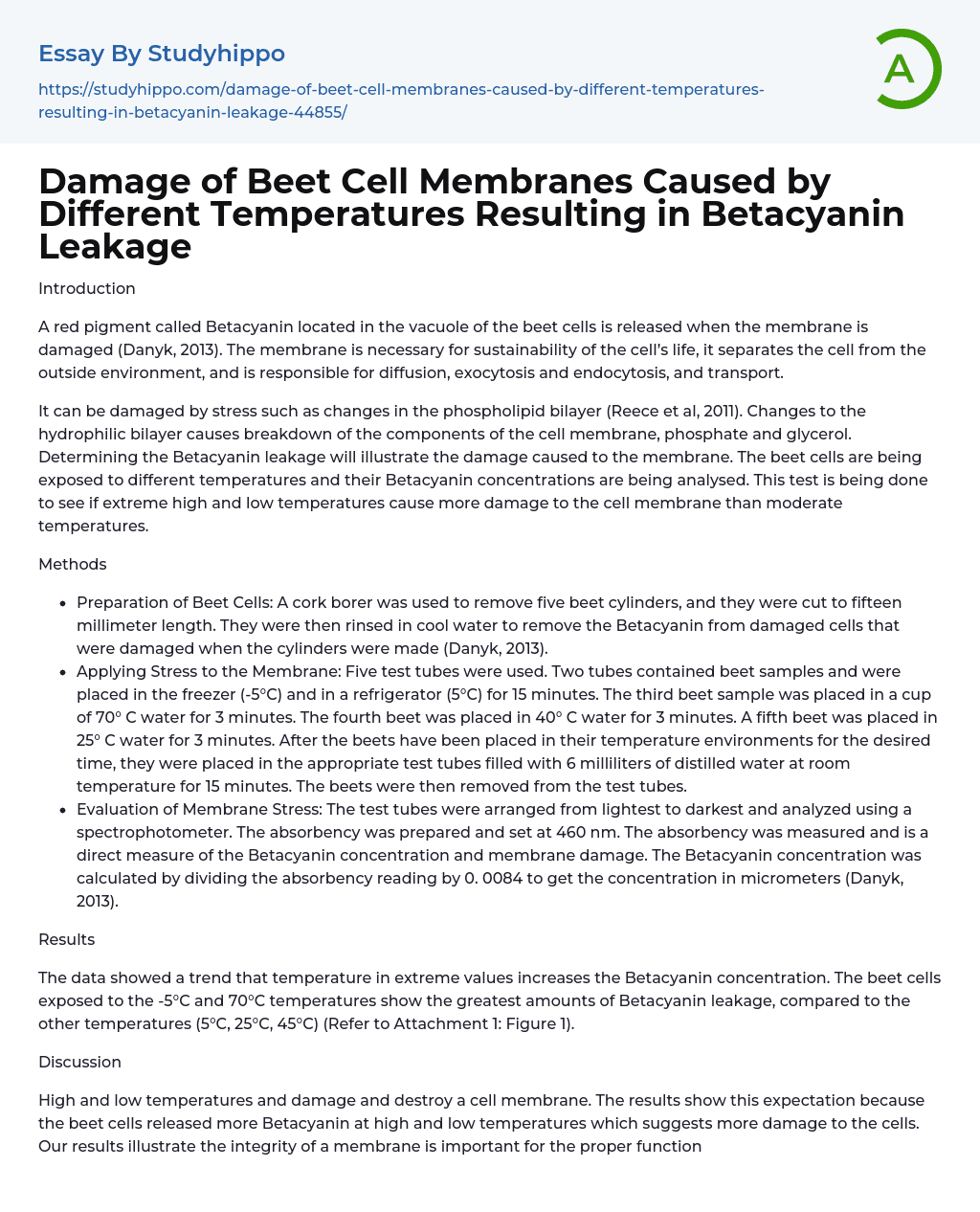Introduction
A red pigment called Betacyanin located in the vacuole of the beet cells is released when the membrane is damaged (Danyk, 2013). The membrane is necessary for sustainability of the cell’s life, it separates the cell from the outside environment, and is responsible for diffusion, exocytosis and endocytosis, and transport.
It can be damaged by stress such as changes in the phospholipid bilayer (Reece et al, 2011). Changes to the hydrophilic bilayer causes breakdown of the components of the cell membrane, phosphate and glycerol. Determining the Betacyanin leakage will illustrate the damage caused to the membrane. The beet cells are being exposed to different temperatures and their Betacyanin concentrations are being analysed. This test is being done to see if extreme high and low temperatures cause more damage to the cell m
...embrane than moderate temperatures.
Methods
- Preparation of Beet Cells: A cork borer was used to remove five beet cylinders, and they were cut to fifteen millimeter length. They were then rinsed in cool water to remove the Betacyanin from damaged cells that were damaged when the cylinders were made (Danyk, 2013).
- Applying Stress to the Membrane: Five test tubes were used. Two tubes contained beet samples and were placed in the freezer (-5°C) and in a refrigerator (5°C) for 15 minutes. The third beet sample was placed in a cup of 70° C water for 3 minutes. The fourth beet was placed in 40° C water for 3 minutes. A fifth beet was placed in 25° C water for 3 minutes. After the beets have been placed in their temperature environments for the desired time, they were placed in the appropriate test tubes filled with
milliliters of distilled water at room temperature for 15 minutes. The beets were then removed from the test tubes.
Results
The data showed a trend that temperature in extreme values increases the Betacyanin concentration. The beet cells exposed to the -5°C and 70°C temperatures show the greatest amounts of Betacyanin leakage, compared to the other temperatures (5°C, 25°C, 45°C) (Refer to Attachment 1: Figure 1).
Discussion
High and low temperatures and damage and destroy a cell membrane. The results show this expectation because the beet cells released more Betacyanin at high and low temperatures which suggests more damage to the cells. Our results illustrate the integrity of a membrane is important for the proper function of the cell. Damage was caused at high and low temperatures but very little was caused at the intermediate temperatures. At hot temperatures the proteins denature and molecules in the cell move faster. At cold temperatures the water freezes, expands, and ruptures the membrane. A mean concentration was calculated from the class, using 5 individual tests.
Literature Cited
- Danyk, H. 2013. Biology 1010: The Cellular Basis of Life Laboratory Manual. University of Lethbridge.
- Reece, J. B. L. A. Urry, M. L. Cain, S. A. Wasserman, P. V. Minorsky and R. B. Jackson. 2011. Campbell Biology, Ninth Edition. Person Benjamin Cummings, San
Francisco, CA.
- Organic Chemistry essays
- Acid essays
- Calcium essays
- Chemical Bond essays
- Chemical Reaction essays
- Chromatography essays
- Ethanol essays
- Hydrogen essays
- Periodic Table essays
- Titration essays
- Chemical reactions essays
- Osmosis essays
- Carbohydrate essays
- Carbon essays
- Ph essays
- Diffusion essays
- Copper essays
- Salt essays
- Concentration essays
- Sodium essays
- Distillation essays
- Amylase essays
- Magnesium essays
- Acid Rain essays
- Mutation essays
- Bacteria essays
- Biotechnology essays
- Breeding essays
- Cell essays
- Cell Membrane essays
- Cystic Fibrosis essays
- Enzyme essays
- Human essays
- Microbiology essays
- Natural Selection essays
- Photosynthesis essays
- Plant essays
- Protein essays
- Stem Cell essays
- Viruses essays
- Agriculture essays
- Albert einstein essays
- Animals essays
- Archaeology essays
- Bear essays
- Biology essays
- Birds essays
- Butterfly essays
- Cat essays
- Charles Darwin essays




